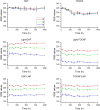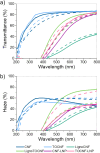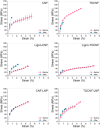Optical assessment of lignin-containing nanocellulose films under extended sunlight exposure
- PMID: 40655478
- PMCID: PMC12254080
- DOI: 10.1007/s10570-025-06380-7
Optical assessment of lignin-containing nanocellulose films under extended sunlight exposure
Abstract
This study investigates the stability and UV-blocking properties of cellulose nanofibril (CNF) and TEMPO-oxidized cellulose nanofibril (TOCNF) films, with and without lignin, under 1000 h of artificial sunlight. The literature to date provides no quantitative analysis of such films' stability, however such insight is critical for optoelectronic applications for instance solar cells. This contribution examines the films from practical perspectives, considering aging with respect to their optical performance and retention of UV protective qualities. Films containing residual lignin (LignoCNF and LignoTOCNF), and lignin nanoparticles (CNF-LNP and TOCNF-LNP) demonstrated remarkable UV-blocking stability; even after the aging transmittance of LignoCNF and CNF-LNP films remained lower than 1% below 390 nm. Most lignin-containing films exhibited increased transmittance between 400 and 600 nm after aging, except for LignoTOCNF, which showed a decrease in transmittance that was comparable to that displayed by non-lignin films. Nevertheless, long-term light exposure induced a decrease in their mechanical properties. Tensile tests revealed increased brittleness in CNF and LignoCNF, while LNP-containing films showed reduced strain at the break. The observed changes were linked to the potential oxidation of COO- groups and structural modifications in both cellulose and lignin. Overall, the incorporation of lignin into nanocellulose films enhances their durability, UV protection, and mechanical stability, making them promising candidates for sustainable optoelectronic applications.
Supplementary information: The online version contains supplementary material available at 10.1007/s10570-025-06380-7.
Keywords: Biobased solar cells; Mechanical properties; Optoelectronics; Stability; UV protection.
© The Author(s) 2025.
Conflict of interest statement
Conflict of interestThe authors declare no competing interests.
Figures







Similar articles
-
Systemic pharmacological treatments for chronic plaque psoriasis: a network meta-analysis.Cochrane Database Syst Rev. 2021 Apr 19;4(4):CD011535. doi: 10.1002/14651858.CD011535.pub4. Cochrane Database Syst Rev. 2021. Update in: Cochrane Database Syst Rev. 2022 May 23;5:CD011535. doi: 10.1002/14651858.CD011535.pub5. PMID: 33871055 Free PMC article. Updated.
-
Home treatment for mental health problems: a systematic review.Health Technol Assess. 2001;5(15):1-139. doi: 10.3310/hta5150. Health Technol Assess. 2001. PMID: 11532236
-
Are Current Survival Prediction Tools Useful When Treating Subsequent Skeletal-related Events From Bone Metastases?Clin Orthop Relat Res. 2024 Sep 1;482(9):1710-1721. doi: 10.1097/CORR.0000000000003030. Epub 2024 Mar 22. Clin Orthop Relat Res. 2024. PMID: 38517402
-
Comparison of Two Modern Survival Prediction Tools, SORG-MLA and METSSS, in Patients With Symptomatic Long-bone Metastases Who Underwent Local Treatment With Surgery Followed by Radiotherapy and With Radiotherapy Alone.Clin Orthop Relat Res. 2024 Dec 1;482(12):2193-2208. doi: 10.1097/CORR.0000000000003185. Epub 2024 Jul 23. Clin Orthop Relat Res. 2024. PMID: 39051924
-
Systemic pharmacological treatments for chronic plaque psoriasis: a network meta-analysis.Cochrane Database Syst Rev. 2017 Dec 22;12(12):CD011535. doi: 10.1002/14651858.CD011535.pub2. Cochrane Database Syst Rev. 2017. Update in: Cochrane Database Syst Rev. 2020 Jan 9;1:CD011535. doi: 10.1002/14651858.CD011535.pub3. PMID: 29271481 Free PMC article. Updated.
References
-
- Abitbol T, Ahniyaz A, Álvarez-Asencio R et al (2020) Nanocellulose-based hybrid materials for uv blocking and mechanically robust barriers. ACS Appl Bio Mater 3:2245–2254. 10.1021/acsabm.0c00058 - PubMed
-
- Banvillet G, Grange C, Curtil D et al (2023) Cellulose nanofibril production by the combined use of four mechanical fibrillation processes with different destructuration effects. Cellulose 30:2123–2146. 10.1007/s10570-022-05016-4
-
- Barclay LRC, Grandy JK, Mackinnon HD et al (1998) Peroxidations initiated by lignin model compounds: investigating the role of singlet oxygen in photo-yellowing. Can J Chem 76:1805–1816
LinkOut - more resources
Full Text Sources
